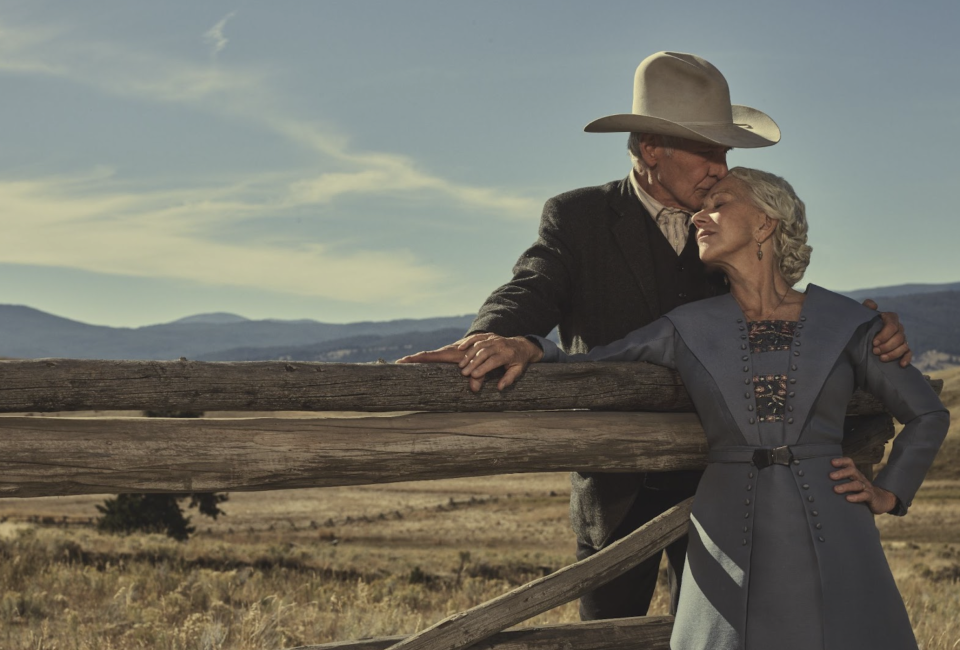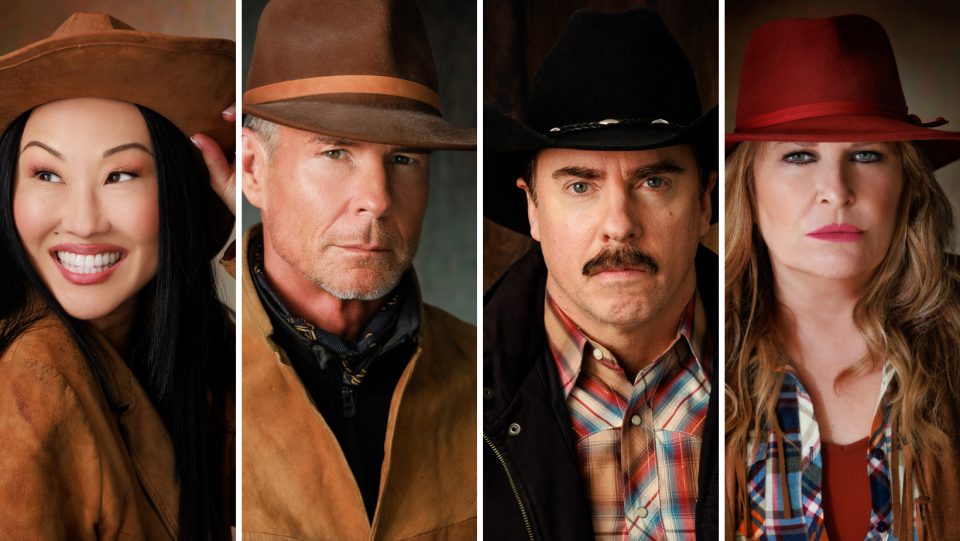The Taylor Sheridan Effect Is Impacting Everything from Production Incentives to Headshots

- Oops!Something went wrong.Please try again later.
In the last 20 years, headshot photographer Andy Rooney has seen trends come and go. The latest? Since January this year, almost every client he’s shot — well over 100 — has wanted to fashion themselves as a “Yellowstone” cowboy.
“Almost everybody I’ve shot so far in the past few months has been shooting those looks as an addition to whatever they’re shooting,” Rooney told IndieWire. “Even people I wouldn’t even have thought would vibe with that. Everybody wants that.”
More from IndieWire
Kevin Costner Will 'Probably' Take Legal Action Over Failed 'Yellowstone' Contract Negotiations
Lily Gladstone Calls 'Yellowstone' a 'Delusional' Portrayal of the American West
Welcome to The Sheridan Effect. Right now, everybody wants a part of Taylor Sheridan and his ever-growing roster of Western-themed shows that began with “Yellowstone” and now includes spinoffs “1883” and “1923” and the upcoming “Land Man,” “Bass Reeves,” and “6666.” (Not to mention “Mayor of Kingstown” and “Tulsa King.”) However, it goes much deeper than acting work; the Sheridan Effect is shaping everything from corporate strategies to government policy.
Sheridan Takes Paramount+
When “Yellowstone” premiered in 2018, Sheridan had two decades as a working actor (“Sons of Anarchy,” “Veronica Mars,” and a whole bunch of one-offs) and three years as a respected screenwriter with “Sicario,” the Oscar-nominated “Hell or High Water,” and “Wind River,” which he also directed.
Expectations for “Yellowstone,” which Sheridan created with John Linson, were modest. Even broadcaster Paramount Network, newly formed from the ashes of Spike TV, wasn’t high on the show: It sold exclusive streaming rights to Peacock. Kevin Costner led the cast as ranch owner John Dutton, but reviews were mixed.
None of that mattered. On basic cable, it quickly became the second-most-watched program behind only “The Walking Dead.” By 2020, “Yellowstone” was the most popular show on cable, period; 4.2 million viewers tuned into the Season 3 premiere that year. In 2021, the Western series drew around 10 million audience members for the Season 4 finale.
According to Whip Media tracking tool TV Time, which records more than 25 million global registered users’ self-reported watching habits, Paramount+ had more top 10 appearances in Q1 2023 than any other network. Paramount+ has 34 appearances, 10 more than Disney (24), 13 more than Netflix (21), and 20 more than Apple TV+ (14). Of those 34, 10 belong to Sheridan: “1923” had seven appearances (including three weeks at No. 1) and “Tulsa King” had three.
“Yellowstone” momentum turned Sheridan into a Paramount Global meal ticket and the bedrock of its television strategy. In 2021, Sheridan inked an overall deal that reportedly paid him $200 million and gave him rope to develop shows across Paramount platforms through 2028.
Sheridan’s value to Paramount is so great that when Sheridan and Costner got into a dispute over filming days, the studio sided with the creator. If “Yellowstone” needs to go on without Costner, so be it. (And if “Yellowstone” 2.0 reverts the streaming rights back to Paramount platforms, so much the better.)

Courtesy of Paramount+
Production Incentives Bigger in Texas
Currently, Texas’ state legislature is debating the passage of a bill that would provide increased tax credits for film and television projects with a budget of at least $15 million. In a campaign update that Texas Lt. Gov. Dan Patrick published February 15, he described Sheridan as the “best screenwriter of our time and one of the best storytellers ever to make movies. Best yet, he’s a Texan and gets Texas. My goal is for Taylor to move all of his TV and movie production to Texas. Working together, I think we can get it done.”
“Yellowstone” shot a few Season 5 sequences south of Dallas in Venus, Texas. “1883” shot some scenes in Granbury, Texas in 2021. Beyond the short-term benefit of the production spend on lodging and transportation, it also brought tourism from hardcore fans. Texas-set “Yellowstone” spinoff “6666” is in development at Paramount+.
It’s not as if “Yellowstone” alerted Texas to the idea that Hollywood can mean mean local money. It’s surrounded by New Mexico and Louisiana, with Georgia to the northeast — states that spent decades building their production infrastructures thanks to generous tax incentives.
Until now, Texas rejected that concept. Too expensive, especially when movies and TV often offend Texan sensibilities. Finally, the gravitational pull of The Sheridan Effect was too great.
On March 3, the Senate introduced HB 3772 for establishment of the Texas Media Production Enticement Program, which would see Texas production incentives increase by a magnitude. Currently the state offers a modest grant with a maximum 20 percent tax credit, under a program that allocates $45 million per year. The new bill, proposed as an add-on devoted to projects budgeted over $15 million, is uncapped and starts with a 30 percent credit; for TV series, it can go as high as nearly 50 percent with various bumps and qualifications. (Lower-budget projects would still access the original grant.)

Courtesy of Paramount
It’s Showtime
Paramount Network head Chris McCarthy, who helped position “Yellowstone” and secured Sheridan’s overall deal, is now CEO of Paramount Media Networks and oversees Showtime, soon to be rebranded “Paramount+ with Showtime.” From there, he wants to turn the Sheridan-verse into its own programming philosophy, creating similar universes out of its most popular programs, like “Dexter,” “Billions,” “Ray Donovan,” and more. This pivot resulted in the cancellation of several shows, selling others, and binning some that didn’t even air.
This franchising frenzy also can be seen at Amazon Prime Video, which reportedly has intentions to develop multiple projects based on IP like “Creed,” “Tomb Raider,” and Spider-Man. On April 28, the streamer will debut “Citadel,” a series from Anthony and Joe Russo intended specifically to launch a “global franchise” of interconnected programs.
Sheridanland
Sheridan joins the ranks of other TV creators who have simultaneously successful shows. Dick Wolf has almost single-handedly filled NBC’s primetime programming for years through the “Law & Order” and “One Chicago” procedurals. Shonda Rhimes made three insanely successful series for ABC — “Grey’s Anatomy,” “Scandal,” and “How to Get Away with Murder” — before moving to Netflix. Ryan Murphy created a mini franchise on FX with his “American Story” anthologies, along with hits like “Glee” and “Pose,” before heading to Netflix.
What makes Sheridan different from Murphy, Rhimes, or Wolf is his volume and velocity. After “Grey’s Anatomy,” Rhimes waited seven years to score her next hit. “Law & Order” ran for nine years before Wolf spun out “SVU.” “Glee” premiered 10 years after Murphy’s first show, “Popular.” Sheridan’s predecessors all came up in the dominant age of cable and network television; he created a bonafide phenomenon on a little-known linear channel.
Wolf mostly stays in his broadcast lane, with his only streaming project being a “Law & Order” show currently in development for Peacock. Murphy made the jump to Netflix with a massive deal in 2018, but his success with “Dahmer” and “The Watcher” are counterweighted by the failures of “The Politician,” “Hollywood,” “Ratched,” and “Halston.” Rhimes doesn’t have many bombs on her resumé, but she has not been nearly as prolific under her Netflix deal as Murphy.

Andy Rooney
I Wanna Be a Cowboy
Everyone wants to be a cowboy. Headshot photographer Rooney has been shooting actor photos since 2005 via his company exactdigital and said that ever since “Yellowstone,” he’s seen client interest in shooting Western-inspired photos climb. This year, it peaked: Practically all of his clients want pictures to show their inner cowboy.
What does a “Yellowstone” shot look like? Rooney described it as “clean, real, and raw” style, with the subject in a hero pose and lighting that adds a bit of grit; occasionally, literal cowboy hats or Western-inspired jackets are also involved.
Best of IndieWire
Sofia Coppola Movies, Ranked: 'Priscilla,' 'The Virgin Suicides,' 'Marie Antoinette,' and More
The 60 Best Sci-Fi Movies of the 21st Century, from 'Melancholia' and 'M3GAN' to 'Asteroid City'
Sign up for Indiewire's Newsletter. For the latest news, follow us on Facebook, Twitter, and Instagram.

